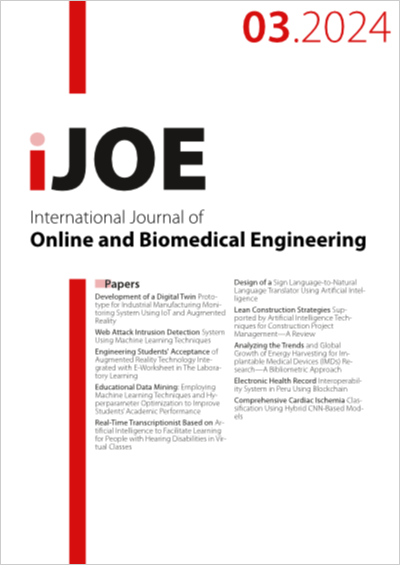Engineering Students' Acceptance of Augmented Reality Technology Integrated with E-Worksheet in The Laboratory Learning
DOI:
https://doi.org/10.3991/ijoe.v20i03.46101Keywords:
Engineering Student’s Attitudes, Integrated Augmented Reality E-Worksheet, Perceived Ease of Use, Perceived UsefulnessAbstract
The use of augmented reality (AR) technology in the field of education has emerged as a rapidly growing trend. However, there is an urgent need for more comprehensive research to determine the reactions of engineering students and their acceptance of this technology in laboratory learning. This study investigates the acceptance of integrated augmented reality with e-worksheet (IARE-W) among engineering students in the laboratory learning (IARE-W) among engineering students the electrical machines course (EMC). This research empirically uncovers the factors that influence it based on the technology acceptance model (TAM), specifically perceived ease of use (PEU) and perceived usefulness (PU). Acceptance is indicated by students’ attitudes toward the use. A survey-based quantitative research study using questionnaires was conducted to collect data, involving 102 students in the field of industrial electrical engineering. The partial least squares structural equation modeling (PLS-SEM) analysis was used to analyze the research data. The results demonstrated that engineering students had a highly positive attitude toward the use of the IARE-W in the EMC. Additionally, both PEU and PU had a positive and significant direct effect on engineering students’ attitudes toward using IARE-W. Furthermore, PEU also had a significant and positive indirect effect through PU as a mediating variable. These findings have significant implications for the development of engineering education and the integration of AR technology in laboratory learning contexts. The results of this study underscore the importance of taking into account PEU and PU in the design, development, and implementation of the IARE-W.
Downloads
Published
How to Cite
Issue
Section
License
Copyright (c) 2023 Doni Tri Putra Yanto, Ganefri Ganefri, Sukardi Sukardi, Jelpapo Putra Yanto, Rozalita Kurani, Muslim Muslim

This work is licensed under a Creative Commons Attribution 4.0 International License.



